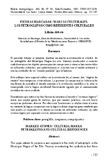| dc.rights.license | http://creativecommons.org/licenses/by-nc-sa/3.0/ve/ | |
| dc.contributor.author | Abbate, Liliana | |
| dc.date.accessioned | 2013-06-19T15:20:35Z | |
| dc.date.available | 2013-06-19T15:20:35Z | |
| dc.date.issued | 2013-06-19T15:20:35Z | |
| dc.identifier.issn | 1325-2610 | |
| dc.identifier.uri | http://www.saber.ula.ve/handle/123456789/37202 | |
| dc.description.abstract | El presente trabajo se propone plantear un nuevo acercamiento al estudio de
los petroglifos del Municipio Nirgua del edo. Yaracuy acentuando el carácter
simbólico que estos objetos poseen para los campesinos y cómo se han convertidos
en referentes culturales que particularizan su relación con el medio ambiente y
con las entidades de un “mundo paralelo” que lo habitan.
Este enfoque hace especial énfasis en la existencia de, al menos, dos “lógicas de
mundo” una campesina y otra urbana. La primera (la campesina) es tributaria de
una forma de entender el mundo anterior a la revolución científica y la otra se
corresponde con la lógica occidental fuertemente signada por el razonamiento
científico de causa y efecto.
Entendemos que entre estas dos formas de entender el mundo o “sistemas lógicos”
existe una amplia gama de matices, que por razones prácticas, en este breve
ensayo no podremos abarcar. Por ahora nos limitaremos a señalar como al entrar
en contacto la lógica campesina con la lógica urbana surge un gran conflicto que
solo puede ser superado si se toman en cuenta los referentes culturales de cada
sistema lógico por separado o en su interacción con el otro. | es_VE |
| dc.language.iso | es | es_VE |
| dc.rights | info:eu-repo/semantics/openAccess | |
| dc.subject | Petroglifos | es_VE |
| dc.subject | Imaginario | es_VE |
| dc.subject | Etnopsiquiatría | es_VE |
| dc.title | Piedras marcadas / Marcas culturales. Los petroglifos como referentes culturales | es_VE |
| dc.title.alternative | Marked stones / cultural marks. Petroglyphs and cultural references | es_VE |
| dc.type | info:eu-repo/semantics/article | |
| dc.description.abstract1 | This paper intends to propose a new approach to the study of petroglyphs in the
Municipio Nirgua of the Edo. Yaracuy accentuating the symbolism that these objects have for farmers and how they have turned into cultural references that
particularize their relationship with the environment and with the entities in a
“parallel world” that inhabit it.
This approach places particular emphasis on the existence of at least two “World
logics” a rural one and a urban one. The first (The urban one) inherit a way of
understanding the world before the scientific revolution and the another one
corresponds to western logic strongly marked by scientific reasoning of cause
and effect.
We understand that between these two ways of understanding the world or
“logical systems” there is a wide range of hues, that for practical reasons, we
can not cover in this brief essay. For now we will just point out how when rural
logic contacts urban logic arises a great conflict that can only be overcome if one
takes into account the cultural references of each logical system separately on
interaction with the another one. | es_VE |
| dc.description.colacion | 137-149 | es_VE |
| dc.description.email | flnag@yahoo.com | es_VE |
| dc.description.frecuencia | semestral | |
| dc.identifier.depositolegal | 198203ME91 | |
| dc.subject.dependencia | Museo Arqueológico "Gonzalo Rincón Gutiérrez" | es_VE |
| dc.subject.keywords | Petroglyphs | es_VE |
| dc.subject.keywords | Imaginary | es_VE |
| dc.subject.keywords | Etnopsychiatry | es_VE |
| dc.subject.publicacionelectronica | Boletín Antropológico | |
| dc.subject.seccion | Boletín Antropológico: Artículos | es_VE |
| dc.subject.thematiccategory | Artes y Humanidades | es_VE |
| dc.subject.tipo | Revistas | es_VE |
| dc.type.media | Texto | es_VE |


